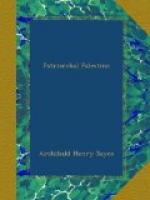Canaan was marked out by Nature to be a land of merchants. Its long line of coast fronted the semi-barbarous populations of Asia Minor, of the AEgean, and of the northern shores of Africa, while the sea furnished it with the purple dye of the murex. The country itself formed the high-road and link between the great kingdoms of the Euphrates and the Nile. It was here that the two civilizations of Babylonia and Egypt met and coalesced, and it was inevitable that the Canaanites, who possessed all the energy and adaptive quickness of a commercial race, should absorb and combine the elements of both. There was little except this combination that was original in Canaanitish art, but when once the materials were given, the people of Palestine knew how to work them up into new and graceful forms, and adapt them practically to the needs of the foreign world.
If we would realize the change brought about by this contact of Canaan with the culture of the stranger, we must turn to the rude figures carved upon the rocks in some of the valleys of Phoenicia. Near Tyre, for example, in the Wadi el-Qana we may still see some of these primitive sculptures, in which it is difficult even to recognize the human form. Equally barbarous in style are the early seals and cylinders made in imitation of those of Babylonia. It seems at first sight impossible to believe that such grotesque and child-like beginnings should have ended in the exquisite art of the age of Thothmes III.
At that period, however, Canaan already had behind it a long civilized past. The country was filled with schools and libraries, with richly-furnished palaces, and the workshops of the artisans. The cities on the coast had their fleets partly of merchantmen, partly of warships, and an active trade was carried on with all parts of the known world. The result was that the wealth of Palestine was enormous; the amount carried away by Thothmes is alone sufficient to prove it. Apart from the natural productions of the country—corn, wine, and oil, or the slaves which it had to furnish—immense quantities of gold, silver, and precious stones, sometimes in their native state, sometimes manufactured into artistic forms, were transported into Egypt. And in spite of this drain upon its resources, the supply seems never to have failed.
The reciprocal influence of the civilizations of Canaan and Egypt one upon the other, in the days when Canaan was an Egyptian province, is reflected in the languages of the two countries. On the one hand the Canaanite borrowed from Egypt words like tebah “ark,” hin “a measure,” and ebyon “poor,” while Canaan in return copiously enriched the vocabulary of its conquerors. As the Travels of a Mohar have shown us, under the nineteenth dynasty there was a mania for using Canaanitish words and phrases, similar to that which has more than once visited English society in respect to French. But before the rise of the nineteenth




